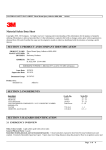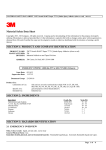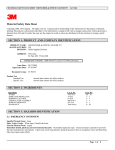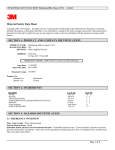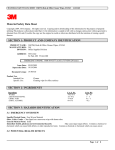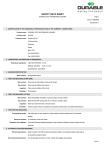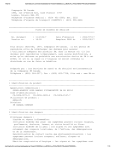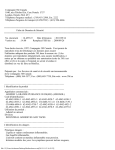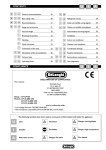Download 3M CL600 equipment cleansing kit
Transcript
MATERIAL SAFETY DATA SHEET 3M(TM) Anti-Static Electronic Equipment Cleaner, #CL600 03/13/2009 Material Safety Data Sheet Copyright, 2009, 3M Company. All rights reserved. Copying and/or downloading of this information for the purpose of properly utilizing 3M products is allowed provided that: (1) the information is copied in full with no changes unless prior written agreement is obtained from 3M, and (2) neither the copy nor the original is resold or otherwise distributed with the intention of earning a profit thereon. SECTION 1: PRODUCT AND COMPANY IDENTIFICATION PRODUCT NAME: 3M(TM) Anti-Static Electronic Equipment Cleaner, #CL600 MANUFACTURER: 3M DIVISION: Office Supplies Division ADDRESS: 3M Center St. Paul, MN 55144-1000 EMERGENCY PHONE: 1-800-364-3577 or (651) 737-6501 (24 hours) Issue Date: 03/13/2009 Supercedes Date: 01/13/2009 Document Group: 23-8724-9 Product Use: Intended Use: Specific Use: Cleaner for Office Electronic Equipment Electronic Equipment Cleaner SECTION 2: INGREDIENTS Ingredient C.A.S. No. % by Wt WATER 2-BUTOXYETHANOL ISOBUTANE AMMONIUM HYDROXIDE 7732-18-5 111-76-2 75-28-5 1336-21-6 90 - 95 3- 8 1- 5 0- 2 SECTION 3: HAZARDS IDENTIFICATION 3.1 EMERGENCY OVERVIEW Odor, Color, Grade: Liquid in aerosol container, foamy white, slight ammonia-like odor General Physical Form: Liquid Immediate health, physical, and environmental hazards: Closed containers exposed to heat from fire may build pressure and explode. Vapors may travel long distances along the ground or floor to an ignition source and flash back. May cause target organ effects. 3.2 POTENTIAL HEALTH EFFECTS _________________________________________________________________________________________________ Page 1 of 8 MATERIAL SAFETY DATA SHEET 3M(TM) Anti-Static Electronic Equipment Cleaner, #CL600 03/13/2009 Eye Contact: Moderate Eye Irritation: Signs/symptoms may include redness, swelling, pain, tearing, and blurred or hazy vision. Skin Contact: Moderate Skin Irritation: Signs/symptoms may include localized redness, swelling, itching, and dryness. Inhalation: Intentional concentration and inhalation may be harmful or fatal. Respiratory Tract Irritation: Signs/symptoms may include cough, sneezing, nasal discharge, headache, hoarseness, and nose and throat pain. Single exposure, above recommended guidelines, may cause: Cardiac Sensitization: Signs/symptoms may include irregular heartbeat (arrhythmia), faintness, chest pain, and may be fatal. May be absorbed following inhalation and cause target organ effects. Ingestion: Gastrointestinal Irritation: Signs/symptoms may include abdominal pain, stomach upset, nausea, vomiting and diarrhea. May be absorbed following ingestion and cause target organ effects. Target Organ Effects: Central Nervous System (CNS) Depression: Signs/symptoms may include headache, dizziness, drowsiness, incoordination, nausea, slowed reaction time, slurred speech, giddiness, and unconsciousness. Blood Effects: Signs/symptoms may include generalized weakness and fatigue, skin pallor, changes in blood clotting time, internal bleeding, and/or hemoglobinemia. SECTION 4: FIRST AID MEASURES 4.1 FIRST AID PROCEDURES The following first aid recommendations are based on an assumption that appropriate personal and industrial hygiene practices are followed. Eye Contact: Flush eyes with large amounts of water. If signs/symptoms persist, get medical attention. Skin Contact: Remove contaminated clothing and shoes. Immediately flush skin with large amounts of water. Get medical attention. Wash contaminated clothing and clean shoes before reuse. Inhalation: Remove person to fresh air. Get immediate medical attention. If Swallowed: Do not induce vomiting unless instructed to do so by medical personnel. Give victim two glasses of water. Never give anything by mouth to an unconscious person. Get medical attention. _________________________________________________________________________________________________ Page 2 of 8 MATERIAL SAFETY DATA SHEET 3M(TM) Anti-Static Electronic Equipment Cleaner, #CL600 03/13/2009 4.2 NOTE TO PHYSICIANS Exposure may increase myocardial irritability. Do not administer sympathomimetic drugs unless absolutely necessary. SECTION 5: FIRE FIGHTING MEASURES 5.1 FLAMMABLE PROPERTIES Autoignition temperature Flash Point Flammable Limits - LEL Flammable Limits - UEL No Data Available Not Applicable 1.1 % [Details: Propellant] 10.6 % [Details: Propellant] 5.2 EXTINGUISHING MEDIA Use fire extinguishers with class B extinguishing agents (e.g., dry chemical, carbon dioxide). 5.3 PROTECTION OF FIRE FIGHTERS Special Fire Fighting Procedures: Water may not effectively extinguish fire; however, it should be used to keep fire-exposed containers and surfaces cool and prevent explosive rupture. Wear full protective equipment (Bunker Gear) and a self-contained breathing apparatus (SCBA). Unusual Fire and Explosion Hazards: Closed containers exposed to heat from fire may build pressure and explode. Vapors may travel long distances along the ground or floor to an ignition source and flash back. Aerosol container contains gas under pressure. Note: See STABILITY AND REACTIVITY (SECTION 10) for hazardous combustion and thermal decomposition information. SECTION 6: ACCIDENTAL RELEASE MEASURES Accidental Release Measures: If possible, seal leaking container. Place leaking containers in a well-ventilated area, preferably an operating exhaust hood, or if necessary outdoors on an impermeable surface until appropriate packaging for the leaking container or its contents is available. Refer to other sections of this MSDS for information regarding physical and health hazards, respiratory protection, ventilation, and personal protective equipment. Call 3M-HELPS line (1-800-364-3577) for more information on handling and managing the spill. Evacuate unprotected and untrained personnel from hazard area. The spill should be cleaned up by qualified personnel. Remove all ignition sources such as flames, smoking materials, and electrical spark sources. Use only non-sparking tools. For large spill, or spills in confined spaces, provide mechanical ventilation to disperse or exhaust vapors, in accordance with good industrial hygiene practice. Warning! A motor could be an ignition source and could cause flammable gases or vapors in the spill area to burn or explode. Contain spill. Working from around the edges of the spill inward, cover with bentonite, vermiculite, or commercially available inorganic absorbent material. Mix in sufficient absorbent until it appears dry. Remember, adding an absorbent material does not remove a toxic, corrosivity or flammability hazard. Collect as much of the spilled material as possible using non-sparking tools. Clean up residue with detergent and water. Collect the resulting residue containing solution. Place in a metal container approved for transportation by appropriate authorities. Seal the container. Dispose of collected material as soon as possible. In the event of a release of this material, the user should determine if the release qualifies as reportable according to local, state, and federal regulations. SECTION 7: HANDLING AND STORAGE _________________________________________________________________________________________________ Page 3 of 8 MATERIAL SAFETY DATA SHEET 3M(TM) Anti-Static Electronic Equipment Cleaner, #CL600 03/13/2009 7.1 HANDLING Do not eat, drink or smoke when using this product. Wash exposed areas thoroughly with soap and water. Keep away from heat, sparks, open flame, pilot lights and other sources of ignition. Ground containers securely when transferring contents. Wear low static or properly grounded shoes. No smoking while handling this material. Do not spray near flames or sources of ignition. Avoid breathing of vapors, mists or spray. Avoid static discharge. Avoid eye contact with vapors, mists, or spray. Avoid contact with oxidizing agents. 7.2 STORAGE Store away from acids. Store away from heat. Store out of direct sunlight. Keep container tightly closed. Store away from oxidizing agents. SECTION 8: EXPOSURE CONTROLS/PERSONAL PROTECTION 8.1 ENGINEERING CONTROLS Do not use in a confined area or areas with little or no air movement. Do not remain in area where available oxygen may be reduced. 8.2 PERSONAL PROTECTIVE EQUIPMENT (PPE) 8.2.1 Eye/Face Protection Avoid eye contact with vapors, mists, or spray. The following eye protection(s) are recommended: Safety Glasses with side shields, Indirect Vented Goggles. 8.2.2 Skin Protection Avoid skin contact. Select and use gloves and/or protective clothing to prevent skin contact based on the results of an exposure assessment. Consult with your glove and/or protective clothing manufacturer for selection of appropriate compatible materials. Gloves made from the following material(s) are recommended: Butyl Rubber. 8.2.3 Respiratory Protection Avoid breathing of vapors, mists or spray. Select one of the following NIOSH approved respirators based on airborne concentration of contaminants and in accordance with OSHA regulations: Half facepiece or fullface air-purifying respirator with organic vapor cartridges. Consult the current 3M Respiratory Selection Guide for additional information or call 1-800-243-4630 for 3M technical assistance. 8.2.4 Prevention of Swallowing Do not eat, drink or smoke when using this product. Wash exposed areas thoroughly with soap and water. Not applicable. 8.3 EXPOSURE GUIDELINES Ingredient 2-BUTOXYETHANOL 2-BUTOXYETHANOL 2-BUTOXYETHANOL AMMONIUM HYDROXIDE AMMONIUM HYDROXIDE ISOBUTANE Authority Type Limit Additional Information ACGIH OSHA OSHA CMRG CMRG ACGIH TWA TWA, Vacated TWA TWA, as ammonia STEL, as ammonia TWA 20 ppm 25 ppm 50 ppm 10 ppm 20 ppm 1000 ppm Table A3 Skin Notation* Skin Notation*; Table Z-1 * Substance(s) refer to the potential contribution to the overall exposure by the cutaneous route including mucous membrane and eye, either by airborne or, more particularly, by direct contact with the substance. Vehicles can alter skin absorption. VAC Vacated PEL:Vacated Permissible Exposure Limits [PEL] are enforced as the OSHA PEL in some states. Check with your local regulatory agency. _________________________________________________________________________________________________ Page 4 of 8 MATERIAL SAFETY DATA SHEET 3M(TM) Anti-Static Electronic Equipment Cleaner, #CL600 03/13/2009 SOURCE OF EXPOSURE LIMIT DATA: ACGIH: American Conference of Governmental Industrial Hygienists CMRG: Chemical Manufacturer Recommended Guideline OSHA: Occupational Safety and Health Administration AIHA: American Industrial Hygiene Association Workplace Environmental Exposure Level (WEEL) SECTION 9: PHYSICAL AND CHEMICAL PROPERTIES Odor, Color, Grade: General Physical Form: Autoignition temperature Flash Point Flammable Limits - LEL Flammable Limits - UEL Boiling point Density Vapor Density Liquid in aerosol container, foamy white, slight ammonia-like odor Liquid No Data Available Not Applicable 1.1 % [Details: Propellant] 10.6 % [Details: Propellant] 10 - 343 ºF 967 g/l >=1 [Ref Std: AIR=1] Vapor Pressure 760 mm [@ 68 ºF] Specific Gravity pH Melting point 0.97 [Ref Std: WATER=1] 11.3 Not Applicable Solubility in Water VOC Less H2O & Exempt Solvents Appreciable 7.9 % SECTION 10: STABILITY AND REACTIVITY Stability: Stable. Materials and Conditions to Avoid: Heat Hazardous Polymerization: Hazardous polymerization will not occur. Hazardous Decomposition or By-Products Substance Condition Carbon monoxide Carbon dioxide During Combustion During Combustion SECTION 11: TOXICOLOGICAL INFORMATION Please contact the address listed on the first page of the MSDS for Toxicological Information on this material and/or its components. SECTION 12: ECOLOGICAL INFORMATION _________________________________________________________________________________________________ Page 5 of 8 MATERIAL SAFETY DATA SHEET 3M(TM) Anti-Static Electronic Equipment Cleaner, #CL600 03/13/2009 ECOTOXICOLOGICAL INFORMATION Not determined. CHEMICAL FATE INFORMATION Not determined. SECTION 13: DISPOSAL CONSIDERATIONS Waste Disposal Method: Dispose of waste product in a permitted hazardous waste facility. As a disposal alternative, Incinerate in a permitted hazardous waste incinerator. Facility must be capable of handling aerosol cans. EPA Hazardous Waste Number (RCRA): D001 (Ignitable) Since regulations vary, consult applicable regulations or authorities before disposal. SECTION 14:TRANSPORT INFORMATION ID Number(s): 70-0715-0339-8 Please contact the emergency numbers listed on the first page of the MSDS for Transportation Information for this material. SECTION 15: REGULATORY INFORMATION US FEDERAL REGULATIONS Contact 3M for more information. 311/312 Hazard Categories: Fire Hazard - Yes Pressure Hazard - Yes Reactivity Hazard - No Immediate Hazard - Yes Delayed Hazard - Yes Section 313 Toxic Chemicals subject to the reporting requirements of that section and 40 CFR part 372 (EPCRA): Ingredient C.A.S. No 2-BUTOXYETHANOL (GLYCOL ETHERS) AMMONIUM HYDROXIDE (AMMONIA COMPOUNDS) 111-76-2 1336-21-6 % by Wt 3- 8 0- 2 STATE REGULATIONS Contact 3M for more information. _________________________________________________________________________________________________ Page 6 of 8 MATERIAL SAFETY DATA SHEET 3M(TM) Anti-Static Electronic Equipment Cleaner, #CL600 03/13/2009 CHEMICAL INVENTORIES The components of this product are in compliance with the chemical notification requirements of TSCA. Contact 3M for more information. INTERNATIONAL REGULATIONS Contact 3M for more information. This MSDS has been prepared to meet the U.S. OSHA Hazard Communication Standard, 29 CFR 1910.1200. SECTION 16: OTHER INFORMATION NFPA Hazard Classification Health: 2 Flammability: 2 Reactivity: 0 Special Hazards: None National Fire Protection Association (NFPA) hazard ratings are designed for use by emergency response personnel to address the hazards that are presented by short-term, acute exposure to a material under conditions of fire, spill, or similar emergencies. Hazard ratings are primarily based on the inherent physical and toxic properties of the material but also include the toxic properties of combustion or decomposition products that are known to be generated in significant quantities. Revision Changes: Section 6: Release measures information was modified. Section 13: Waste disposal method information was modified. Section 15: 311/312 Fire Hazard score was modified. Section 15: 311/312 Delayed Hazard score was modified. Section 5: Flash point information was modified. Section 9: Flash point information was modified. DISCLAIMER: The information in this Material Safety Data Sheet (MSDS) is believed to be correct as of the date issued. 3M MAKES NO WARRANTIES, EXPRESSED OR IMPLIED, INCLUDING, BUT NOT LIMITED TO, ANY IMPLIED WARRANTY OF MERCHANTABILITY OR FITNESS FOR A PARTICULAR PURPOSE OR COURSE OF PERFORMANCE OR USAGE OF TRADE. User is responsible for determining whether the 3M product is fit for a particular purpose and suitable for user's method of use or application. Given the variety of factors that can affect the use and application of a 3M product, some of which are uniquely within the user's knowledge and control, it is essential that the user evaluate the 3M product to determine whether it is fit for a particular purpose and suitable for user's method of use or application. 3M provides information in electronic form as a service to its customers. Due to the remote possibility that electronic transfer may have resulted in errors, omissions or alterations in this information, 3M makes no representations as to its completeness or accuracy. In addition, information obtained from a database may not be as current as the information in the MSDS available directly from 3M. _________________________________________________________________________________________________ Page 7 of 8 MATERIAL SAFETY DATA SHEET 3M(TM) Anti-Static Electronic Equipment Cleaner, #CL600 03/13/2009 3M MSDSs are available at www.3M.com _________________________________________________________________________________________________ Page 8 of 8








